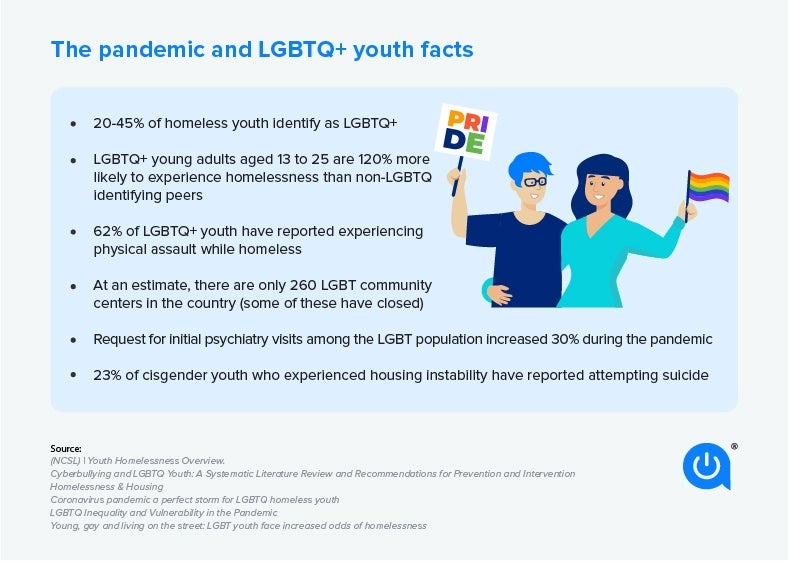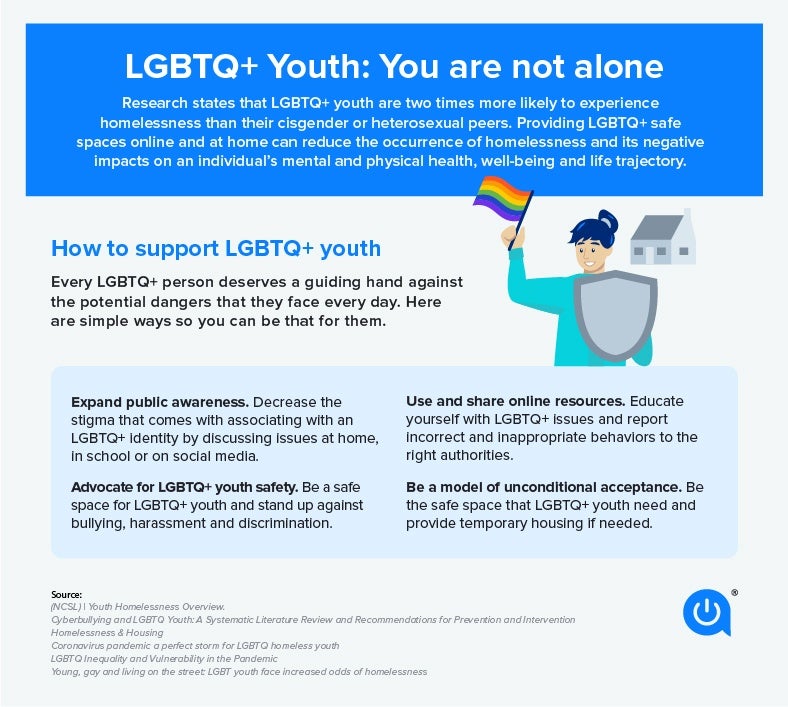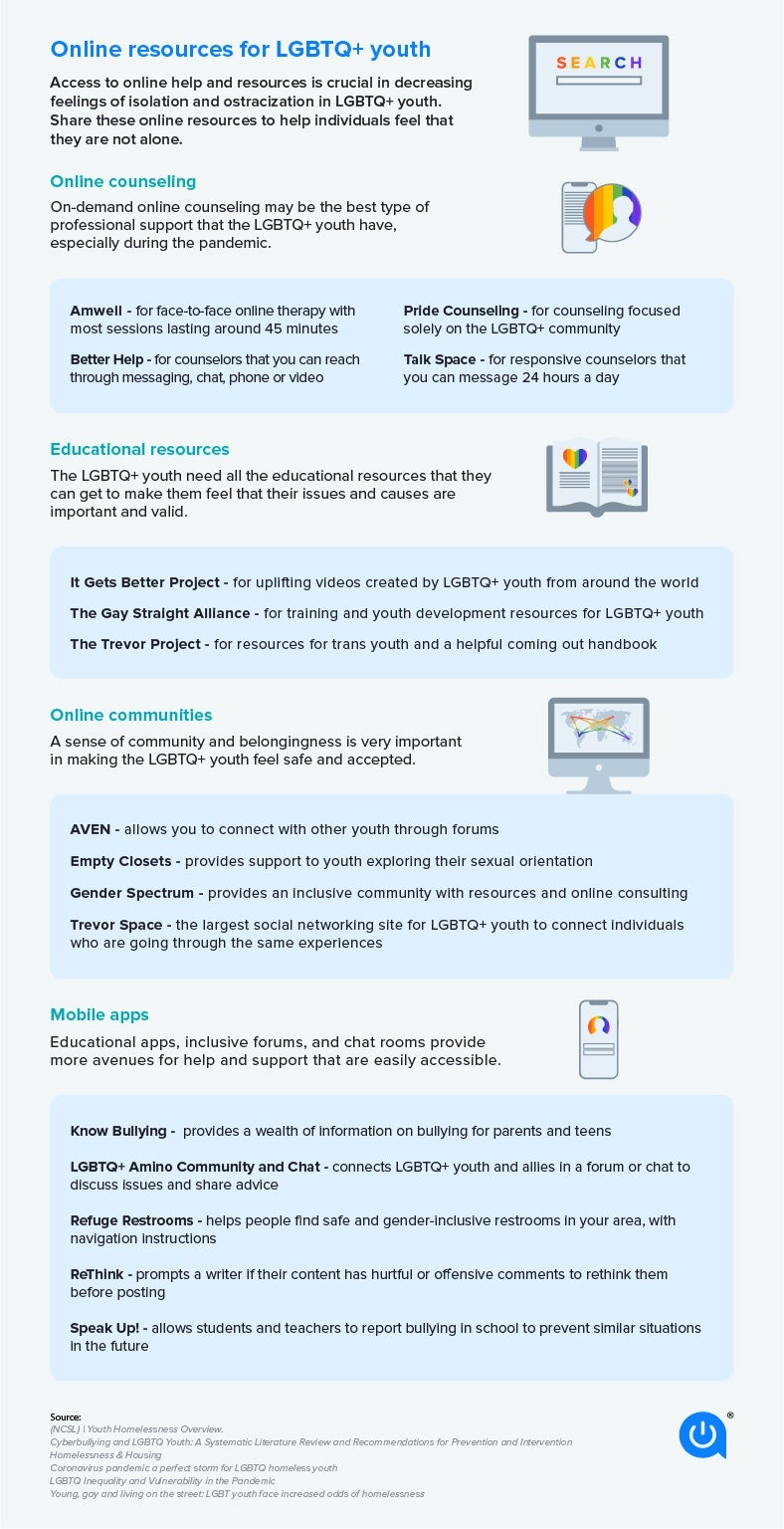As Americans regroup after two years of a pandemic lifestyle, studies are revealing that youth who are in the sexual and gender minority are experiencing depression and anxiety at a faster rate than other groups.
In fact, The Trevor Project 2022 National Survey on LGBTQ Youth Mental Health found that “45% of LGBTQ youth seriously considered attempting suicide in the past year,” with 60% of the youth who wanted mental health care in the past year unable to access it. The survey also found that 73% of LGBTQ youth reported having symptoms of anxiety.
Being an LGBTQ young person, unfortunately, means that during their critical adolescent years, they can often feel isolated and misunderstood, lacking the resources they need to maintain their mental health.
With pandemic-related measures in place across the country, youth are at an even greater risk of social isolation and depression. But online resources, including supportive and educational materials, can help them maintain mental and emotional health.
In a Catch-22, the internet can make this necessary information accessible, but only if you have access to an internet service.
In this guide, Allconnect researchers take a look at available online resources, as well as address the digital divide and homeless issues within the LGBTQ youth community.

Challenges facing LGBTQ youth
LGBTQ youth can face some unique challenges, such as higher rates of depression and suicide than their peers. A behavioral health report on youth.gov noted that suicide is the third leading cause of death among youth and young adults, and up to 33% of LGBTQ youth report having attempted suicide. LGBTQ high school students are also two to seven times more likely to commit suicide than their peers.
Along with all the pressures of growing into their own identities, they have increased risks of alcohol and drug use, bullying, peer pressure, depression, suicide attempts and high-risk sexual activities. LGBTQ youth and young adults may be kicked out of their homes, and often face homelessness.
Identifying as LGBTQ doesn’t cause depression or mental health issues. The cause is rooted within outside factors: Discrimination, family rejection, negative biases and bullying and hostile microaggressions that can lead to suicidal ideation, according to the report. When LGBTQ youth aren’t accepted for who they are, they have higher rates of stress, anxiety, depression, self-harm behaviors and other disturbances to mental health.
In addition, many LGBTQ youth are confronted with online bullying. Pre-pandemic, 32% of teens aged 14-17 spent about four hours in front of screens. As of June 2020, that number leaped to 62%, according to a Statista report.
Cyberbullying has made the internet a dangerous place for LGBTQ youth, and approximately 48.7% of LGBTQ students are victims of cyberbullying each year. This can be through private text messages or public posts on social media. Cyberbullying leads to high rates of psychological and emotional distress for LGBTQ+ youth, as well as low self-esteem, social isolation, depression and thoughts of suicide.
Bridging the digital divide
Resources are only as useful as the connection you have to them. Unfortunately, there is a gaping digital divide in America, with over 40 million people lacking access to the internet, and nearly 160 million lacking high-speed access. This gap affects low-income families, the homeless population and other marginalized communities, including LGBTQ youth.
According to an LGBT Tech impact report, 2.9 to 3.8 million LGBTQ+ people live in rural areas with little access to LGBTQ+ resources outside of the internet.
In “An LGBT Broadband Future” report, key findings included:
- The LGBTQ community relies on the internet “for the important tasks of identity formation, peer connection and identification of partners.”
- Community members “depend on the internet for job seeking and navigating during times of a discriminatory economic landscape.”
- LGBTQ youth “often use their phones for safety when faced with challenges of crime or homelessness.”
The internet has become a place for everyone to stay connected to family, friends, work and more, but without that online connection, young people can be affected in many ways:
- Emotional and social isolation: The online world is one where youth can find emotional and social connections that may be missing at home. The teen years are key ones in their development. COVID-19 protocols saw many resource centers closing their doors and that left youth who didn’t have an internet connection without the important emotional and social support they needed. During COVID-19 restrictions, according to The Trevor Project Survey, over 60% of LGBTQ youth said their home wasn’t affirming and almost 2 in 5 LGBTQ youth said they lived in a community that wasn’t accepting of LGBTQ people.
- Secrecy of identity: The Power On report also shared that 73% of LGBTQ youth are more honest about themselves online versus in the real world.
LGBTQ advocacy

Organizations like LGBT Tech are advocates of providing technology and broadband services to this underserved community and “empowers LGBTQ communities and individuals, and ensures that media, telecom and high technology issues of specific concern to LGBTQ communities are addressed in public policy conversations.”
PowerOn, a program of LGBT Tech, shares its mission as a program “that distributes technology to homeless, isolated, and disadvantaged LGBTQ+ individuals across the country.” Their PowerOn Partner Centers provide places where people can connect online and reach necessary resources.
In a petition to the Federal Communications Commission on the Affordable Connectivity program, LGBT Tech stated, “The issues of connectivity and access are even more critical for LGBTQ people of color in rural areas who are often at risk of multiple types of discrimination, further limiting their chances to access quality services, health care, and employment. Further amplifying this problem, many service providers in rural areas are religiously affiliated and are covered under religious exemption laws that may allow them to discriminate. For these LGBTQ+ individuals, broadband connectivity may be the only way to access medical, mental health or employment opportunities not available in their local communities due to discrimination.”
Homelessness and LGBTQ youth
Home is where we often head if we need a safe place to just “be” us. Unfortunately, many LGBTQ youth find that after sharing their preferences with family, their home is no longer that safe refuge.
In fact, LGBTQ youth have a 120% higher risk than their peers of becoming homeless, according to the Chapin Hall, Voice of Youth Count report.
The Trevor Project reports LGBTQ+ youth represent 40% of the homeless youth population. The report finds that homelessness among LGBTQ+ youth can result from “family rejection, discrimination, criminalization and a host of other factors.” The organization also found that LGBTQ youth who report having at least one accepting adult were 40% less likely to report a suicide attempt in the past year.
The resources listed below are a good starting point if you know of, or are, a youth in need.
Online resources for LGBTQ youth

Online counseling
LGBTQ youth may have a hard time accessing in-person counseling, but online counseling provides flexible support. Whether on the phone, in a chat or via texting, online counseling can be convenient and inexpensive.
- Talk Space: This platform features thousands of licensed therapists who will provide guidance and support, and you can contact your therapist using a laptop or smartphone. The conversation will be synced across devices, so you can access help wherever you are. On Talk Space, messages can be sent 24 hours a day, and the therapist will respond one or two times per day.
- Pride Counseling: Focused on providing counseling for the LGBTQ community, Pride Counseling will match youth with a licensed therapist. They provide support for identity and mental health issues in a safe space. It’s possible to message a counselor 24 hours a day, as well as schedule counseling sessions.
- Better Help: Better Help has a large network of licensed counselors, and you can reach a counselor through messaging, chat, phone or video. For LTGBQ youth seeking online counseling, Better Help has affordable and convenient counseling services.
- Amwell: Providing LGBTQ counseling, Amwell offers face-to-face online therapy either on your computer or using a mobile app. Most sessions last around 45 minutes and must be scheduled in advance.
Educational resources
It’s important for LGBTQ youth to understand that they’re not alone. Educational resources can provide more information on discrimination and bullying, how to effectively deal with this harassment and where to find help.
- The Trevor Project: Offering a wealth of information to LGBTQ youth and allies, the Trevor Support Center answers frequently asked questions on topics such as gender identity and sexual orientation. You’ll also find the coming out handbook and resources for trans youth.
- The Gay Straight Alliance: From training youth leaders, supporting LGBTQ+ youth organizers and supporting LGBTQ youth development, the Gay Straight Alliance Network unites teenagers across the country.
- It Gets Better Project: For inspiring stories from LGBTQ youth, the It Gets Better Project provides uplifting video stories created by LGBTQ youth around the world.
A sense of community
Connecting with a community helps LGBTQ young adults feel a sense of belonging. Communities provide additional resources, encourage youth to share their stories and have platforms where youth make friends with people who can understand their journey.
- Trevor Space: This international community is the world’s largest social networking site for LGBTQ youth. On Trevor Space you can create a custom profile, join a discussion forum and connect with people who are going through similar experiences.
- Gender Spectrum: This is an inclusive space for all LGBTQ youth. From resources and online consulting to online groups for teens and family members, they provide a community rooted in understanding and inclusion.
- Empty Closets: This online community offers a forum where you can join a chat, start a discussion and find additional resources. Empty Closets will provide support to youth as they explore their sexual orientation.
- AVEN: The AVEN community promotes thoughtful and honest conversations about asexuality, and welcomes members who identity as sexual or asexual. AVEN allows you to connect with other youth through forums.
Find a community near you
Download this clickable list of U.S. LGBTQ youth community centers.
Staying safe online
Cyberbullying is a major issue for LGBTQ youth online. Be aware of the risks when using social media, and learn what to do if you are bullied online. Follow these cyberbullying safety tips to stay safe when you’re online.
- Don’t respond: If you’ve been targeted by an online bully, your gut reaction might be to respond. However, responding to a bully gives them more power, and shows them that they’ve hurt you. Avoid responding or retaliating to a cyberbully, and leave messages unanswered.
- Save messages: You don’t want to reread hurtful comments, but saving messages is the best way to put an end to cyberbullying. Show these messages to a trusted family member or counselor who can help. Even minor comments can escalate into something major, so save these messages.
- Block the bully: If you’ve been receiving private messages, you can block the bully, preventing them from sending you any more messages. If you’re in a chat together, leave the chat.
- Talk to someone: When you experience cyberbullying, talk to a trusted parent, school counselor or online counselor for support. They’ll help you find out if you can report the incident anonymously at school, as well as help you process your emotions.
Ways parents and loved ones can help
As a parent, you can support your teenager and help them maintain their mental health. These are four ways you can help your teenager, and you can easily find supplemental resources on the internet that provide information to families of LGBTQ youth.
- Find and use online resources: Take the time to educate yourself about LGBTQ issues and the challenges your teenager may encounter. Kickstart your research by finding out if you’re an askable parent, then learn more about the LGBTQ community.
- Share online help resources with your teenager: Gather a list of online resources that provide help and support to LGBTQ youth. Make sure your child can access online counseling, educational resources, mobile apps and an online community. They’ll feel supported as they explore their identity.
- Utilize parental controls: Every device, gaming console and streaming service offers some form of parental controls. Whether limiting the amount of time spent online or only allowing access to certain content, it is worth your time as a parent to check into these options. You can also talk to your internet service provider to see if they provide any tools to use when monitoring your child’s activities online.
- Advocate for your child: If your teenager has been harassed, bullied or discriminated against, become their strongest advocate. Meet with teachers and school administration to report and correct inappropriate and harmful behavior. Be their advocate among family members as well, and make sure your child is never harassed at home.
Other resource and advocacy groups
- The National Coalition of Anti-Violence Programs – The program offers direct services to survivors of all forms of violence and their circle of family and friends. They also work on policy and advocacy, and provide “free, holistic legal services to LGBTQ and HIV-affected survivors in all five boroughs of New York City in Family Court, Housing Court, Civil Court and with immigration matters.”
- GLAAD LGBTQ Resource List – GLAAD shares stories from the LGBTQ community and this list includes resources in politics, military, aging, legal and other sectors.
- The TrevorLifeline – Provides a national crisis intervention and suicide prevention lifeline for LGBTQ youth.
- Homelessness Help – Provides resources for homeless LGBTQ individuals in crisis, as well as provides a reporting platform for housing discrimination or violations.
- National Runaway Safeline – A hotline for youth who need someone to hear them, as well as for concerned adults.
- The LGBT National Youth Talkline – Free and confidential peer support for LGBTQ youth 25 and under.
- Trans Lifeline – Run by trans people, this lifeline provides peer support.
- National Suicide Prevention Lifeline – Free and confidential support for anyone in distress, suicide prevention and resources.
- TheRecoveryVillage.com – A free web resource that provides information about addiction, eating disorders and mental health issues.
Written by:
Robin LaytonEditor, Broadband Content
Robin Layton is an editor for the broadband marketplace Allconnect. She built her internet industry expertise writing and editing for four years on the site, as well as on Allconnect’s sister site MYMOVE.com. …
Read more

Edited by:
Joe SupanPrincipal Writer, Broadband Content
Freelance writer Vanessa Jerusalimiec also contributed to this article.
-
Featured
![Keep your kids safe online: All you need to know about internet safety at school and home]() Keep your kids safe online: All you need to know about internet safety at school and home David Anders — 11 min read
Keep your kids safe online: All you need to know about internet safety at school and home David Anders — 11 min read -
Featured
![Guide to low-income internet options and affordable internet plans]() Guide to low-income internet options and affordable internet plans Robin Layton — 4 min read
Guide to low-income internet options and affordable internet plans Robin Layton — 4 min read -
Featured
![Emergency Broadband Benefit: How to get $50/mo. off your internet bill]() Emergency Broadband Benefit: How to get $50/mo. off your internet bill Joe Supan — 8 min read
Emergency Broadband Benefit: How to get $50/mo. off your internet bill Joe Supan — 8 min read
Latest
-
Thursday, July 25, 2024
Worried about losing your signal? This is how to keep your satellite dish cleanDavid Anders — 6 min read
-
Tuesday, July 23, 2024
The best free TV and movie streaming services 2024Camryn Smith — 5 min read
-
Tuesday, July 23, 2024
Everything you need to know about internet speedsRobin Layton — 8 min read






